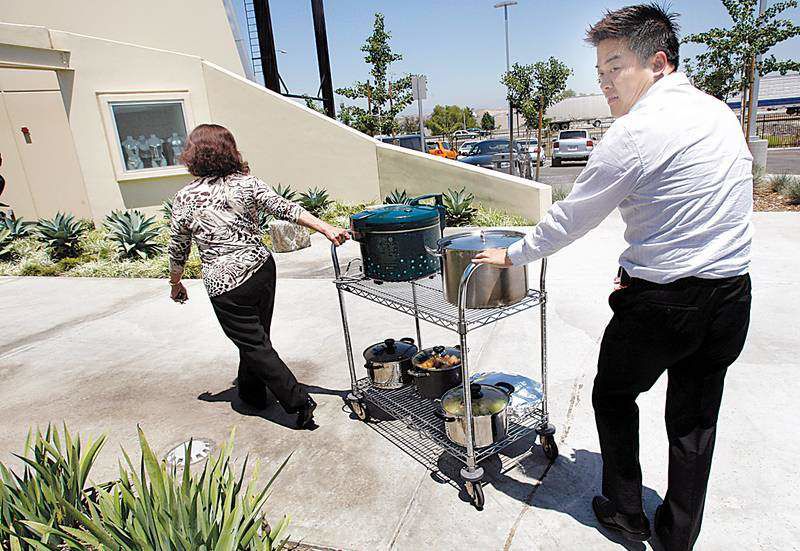Near L.A., not your usual Chinatown
Published 5:00 am Sunday, June 22, 2008

- Suipao Tsai and her son Mike deliver a homemade lunch every day to employees of the family’s lingerie firm in the City of Industry, Calif.
LOS ANGELES — The celery and squid sizzle in Suipao Tsai’s blackened wok as she prepares lunch for up to six-dozen employees of the family’s multimillion-dollar lingerie business in the City of Industry, adjacent to Los Angeles.
It’s a scene repeated every weekday morning at her palatial family compound in the hills of Rowland Heights.
Trending
Chicken is deep-fried on an outdoor cooking island by the pool and waterfall. A Mercedes-Benz SUV parked next to an 18-foot koi pond is lined in the back with old Chinese newspapers and loaded with a steaming pot of beef brisket and turnip stew.
After the Mercedes arrives at the company, the mostly Asian employees fill plates with heaps of food, then sit quietly eating and watching a Mandarin-language talk show on a flat-screen TV.
“It’s a cultural thing,” said Mike Tsai, Suipao Tsai’s second son and chief operating officer of the family’s company, Leg Avenue. “My father used to be responsible for providing lunch for 200 employees” in Taiwan. “We brought that tradition here to America.”
In fact, much of the eastern San Gabriel Valley has more in common with Taipei, Bejing or Shanghai than it does with neighboring Los Angeles. Here, Asian-immigrant entrepreneurs have transformed once-sleepy suburbia into a Chinatown like no other. They are far from struggling newcomers trying to achieve the American Dream in other nearby Chinese enclaves. Here, the power of Chinese culture and its economy is on display, said Joel Kotkin, an expert in urban affairs and ethnic economies.
“It’s so overwhelming,” he said. “It’s a suburb anchored to the tribal economy of the Chinese and China. They have an ideal life with a spacious backyard, and institutions and amenities close by. You have a 15-minute commute to work rooted in City of Industry. You don’t have to step out.”
And many don’t.
Trending
Since the family moved its offices to the City of Industry two decades ago, Mike Tsai says he’s visited China and Taiwan more than he’s been to downtown L.A.
Tsai and other Asian entrepreneurs have created office parks where most of the signs are in Chinese. At the trendy shopping arcades, one is more likely to hear Mandarin than English.
At Life Plaza, Tony Liu works at a high-end sneaker store. The 24-year-old from northern China has been in the United States for two years and said it often feels like he never left home.
“I never get to practice my English,” said Liu. “Sometimes it feels like I’m still in China.”
‘A stopo
ver’
The combined populations of Rowland Heights, Hacienda Heights, Walnut and Diamond Bar have not only doubled in the last two decades but are now two-thirds Asian. Close to 40 percent of the businesses in City of Industry are ethnic-Chinese-owned.
Up the hill from Life Plaza, at Blandford Elementary, close to 60 percent of the students are Asian.
Many are the children of wealthy immigrants, dropped off in luxury cars by their mothers. Many fathers are absent, working in China.
Parent volunteer Rosy Chong said she overheard a newly arrived Korean parent’s daughter ask her mother, “When are we going to America?”
“She thought Rowland Heights was a stopover” in Asia, Chong said.
For the teachers and administrators at Blandford, the demographic changes have been both a blessing and a challenge.
The cultural premium parents place on education has helped make Blandford the top-performing elementary school in the district. A waiting list was established to handle the high demand for enrollment.
Blandford Principal Jo Ann Lawrence said some parents told her they were reluctant to send their children to another school in the district because there were too many Latino students there.
“I’m not one to feel you have to be a melting pot; I value what each group brings,” she said. “But the isolation concerns me.”
Teacher Cindy Kim sees it first -hand in her classroom. In an environment so dominated by Chinese and Koreans, it’s difficult to teach lessons about other cultures. “Our big holiday is Chinese New Year.”
Success story
The Tsai family moved to Southern California in 1984, fearing the political instability in Taiwan. They started modestly by selling cheap toys at a flea market. They then sold hosiery.
The Tsais’ fortunes increased dramatically in 2000 when Leg Avenue began making and designing sexy Halloween costumes for women. They used old connections to secure factories outside Taipei, and in Guangzhou and Shanghai to manufacture the designs economically.
The racy nurse and pirate outfits became so popular the company went from $1 million in sales in 2000 to $87 million last year.
Their original Rowland Heights property has grown to become a 1.5-acre plot featuring three houses shared by more than 20 family members and a fleet of luxury cars. The family imported ancient wood chairs and stone from Taiwan to form a table under their courtyard gazebo.
Their annual Chinese New Year’s parties have become affairs for 400. This year’s party featured Peking duck, rowdy Taiwanese dice games and the doling out of $30,000 in red “lucky money” envelopes to visitors.
“Even though we’ve gone corporate, the Taiwanese family structure is always there,” Mike Tsai said.








